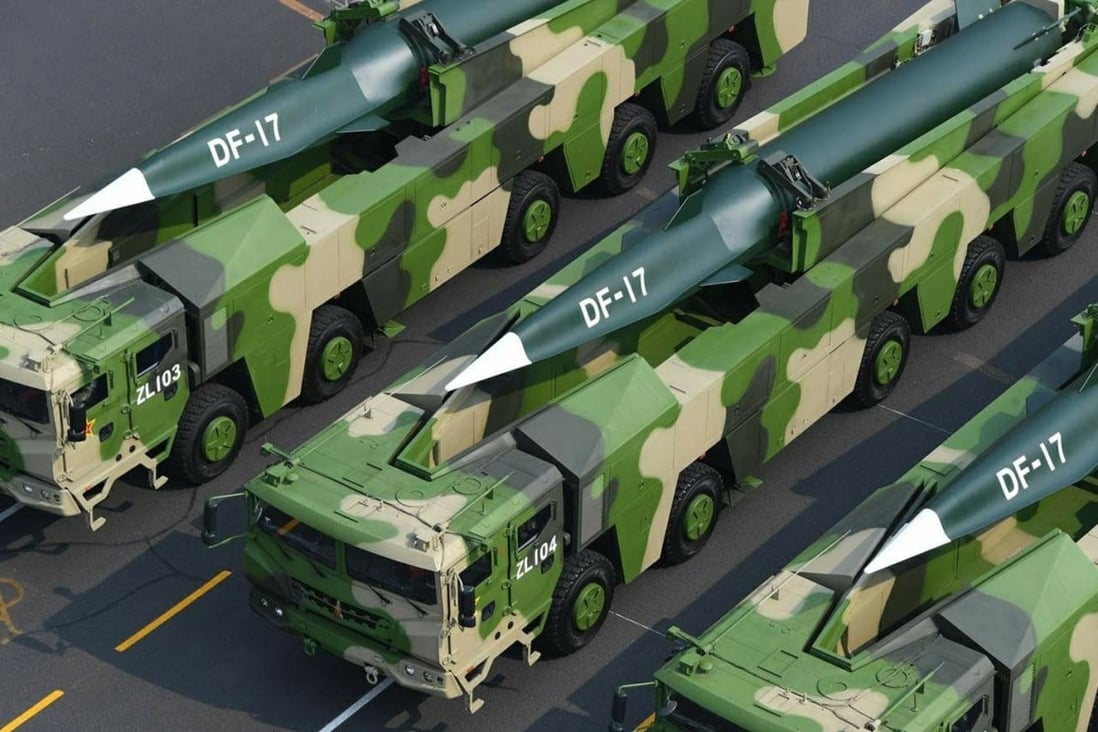China is allegedly developing AI-enabled launchers for its Dongfeng family of road-mobile missiles as part of a strategy to produce next-generation weapons. These launchers could avoid being noticed by drones, radars, and satellites, reported SCMP, citing state broadcaster CCTV.
Pakistan Getting Bayraktar TB2 Drones Into Its Air Defense Network; Aims To Promote “Synergy” In Counter-Air Ops
Ukraine Eyes Indian Co-Developed Air Defence System To Counter Russia’s ‘Missile Rain’ & Iranian Drones
Chinese scientists seek to employ artificial intelligence technologies to make missile launchers more tactical and “invisible.”
In the future, China’s adversaries won’t be able to detect or locate its missile launchers on the battlefield, according to a researcher who worked on developing the launch vehicle for the DF-17 hypersonic missile.
Yang Biwu, a PLA Rocket Force expert, described the relationship between the missiles and the launch platform as being similar to “bullets and a gun” and suggested that Beijing can look into the possibility of using the platform to provide itself with more options in the event of future conflict.
The DF-17 medium-range missile, capable of purportedly breaching US missile defenses, is advertised as the world’s first operational hypersonic glide vehicle weapon. The report noted, citing a source, that the DF-17 launch vehicle is a modified version of the one used for the DF-16B ballistic missiles.

The report noted that the medium-range DF-16B and DF-17 missiles were developed as offensive weapons for the Taiwan issue and were meant to deter any foreign military intervention in the Taiwan Strait.
The video released by CCTV featured camouflage launchers for missiles like the DF-41 solid-fuel road-mobile intercontinental ballistic missile. With an estimated range of more than 12,000 kilometers, the DF-41 can supposedly target the United States mainland.
Most Dongfeng, or DF, series missiles can launch conventional and nuclear warheads. According to military analyst and former PLA instructor Song Zhongping, the camouflage and design of missile launchers are essential aspects of battlefield strategy.
He explained that with China’s nuclear policy of “no first use,” which necessitates more robust defense while preparing for a “second strike,” protecting personnel and weapons is always of the utmost importance in combat situations.
The state-run media reportedly also featured footage showing a new fighter jet being created for the newly launched Fujian aircraft carrier, along with new vessels, equipment, and tanks with AI capabilities.
China’s ‘Dongfeng’ Missiles
Dongfeng missiles, also known as DF missiles, are a class of ballistic missiles capable of engaging targets at short, medium, intermediate, and even intercontinental ranges. The DF class of missiles is operated by the Chinese People’s Liberation Army Rocket Force.
The China Aerospace Science and Industry Corporation (CASIC), a state-owned aerospace and defense organization, manufactures a wide range of DF missiles with varying warhead-carrying capabilities. The missiles have boosted China’s deterrence capability significantly.
In August 2022, the Chinese armed forces fired 11 DF ballistic missiles into the waters close to Taiwan’s northeast and southwest borders. The DF-41 missile is the most powerful and capable member of the DF missile family.
Military Today ranked China’s DF-41 as one of the world’s deadliest intercontinental ballistic missiles (ICBMs). Military Today defined the missile as a solid-fuel missile that can “sufficiently reach all territories” of the United States, Europe, and Russia.
It is estimated that a DF-41 launched toward the United States would take 20 to 25 minutes to reach its target and have “extremely devastating” consequences that could theoretically “wipe out entire countries.”
The missile’s total payload is 2,500 kilograms, and it can transport up to ten independently targeted nuclear warheads (MIRV). The Tian HTF5980 1616 TEL is used to transport the missile.
The missile’s initial flight test was carried out in July 2012. In December 2015, a rail-mobile launcher was used to test the missile’s canister ejection. In October 2019, the missile was made public for the first time.
On the other hand, the DF-16 was put into service in 2011. It has a range of 1,000 kilometers and can deliver payloads up to 1,000 kilograms. It can carry up to three high explosive, nuclear, or submunition MIRV warheads, with Taiwan and Vietnam within its target range.
In 2021, the US Department of Defense warned about the “growing threat the world faces” from China’s increasing nuclear arsenal. The warning came after satellite pictures revealed 230 silo-based ICBM launch sites in Gansu, Yumen, and Hami, Xinjiang.
- Contact the author at ashishmichel@gmail.com
- Follow EurAsian Times on Google News